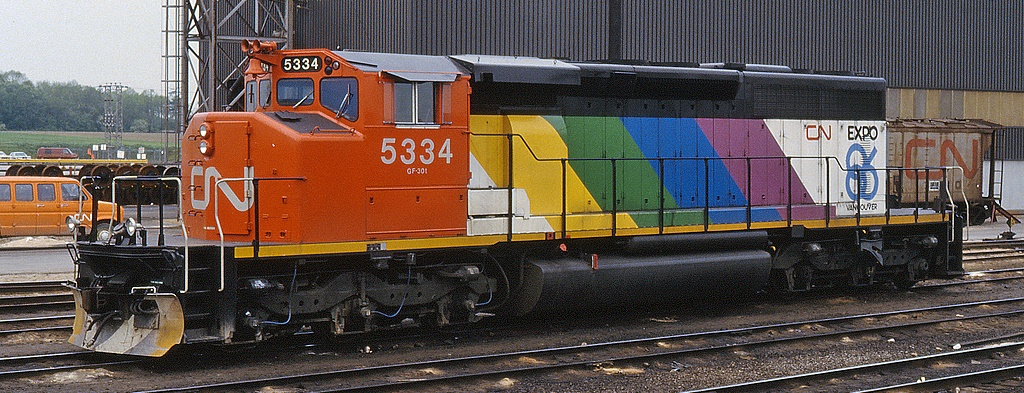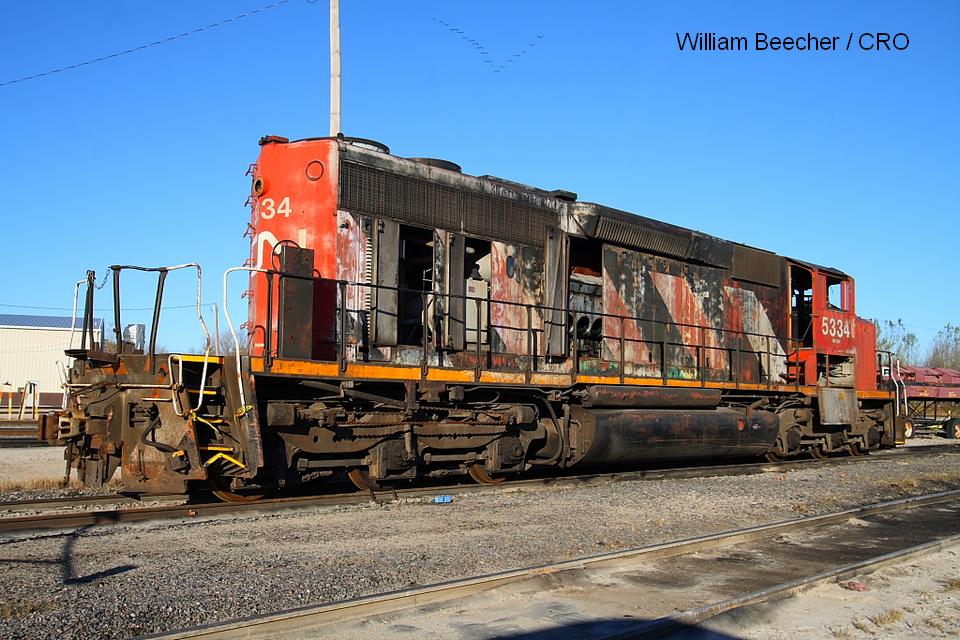InterMountain EMD SD Series – Canadian National SD40-2W
Last updated on: 2021-08-09

InterMountain released in February 2018 the GMD SD40-2W; this is the second model of their EMD SD Series based on the new chassis introduced in December 2016 on the SD40-2. Further releases are planned with SD38-2 and SD40T-2. It is proposed either in DC, DCC-no sound or DCC with sound. The model is available in various CN paint schemes as well as in various road names of companies that purchased the prototype from CN.
About the prototype

The SD40-2W – also noted SD40-2(W) – is the Canadian National version of the SD40-2; it was built by the Diesel Division of General Motors of Canada Ltd. (formerly General Motors Diesel - GDM) of London, Ontario; 123 were constructed between May 1975 and December 1980. The major difference between the SD40-2W and a regular SD40-2 is the fitment of a wide-nose Canadian comfort cab, commonly denoted by adding a 'W' in the model name (although the GMD designation on the builder’s plates remained 'SD40-2').
According to Canadian National classification, the CN SD40-2W are classified as GF-30n, GF-30p, GF-30q, GF-30r, GF-30s or GF-30t depending on their production batch. Class number is printed on the cab just below the road number, but you might need a magnifier to see it on this N scale model.
The Expo '86
I purchased the colorful Expo ’86 version that is only available with one road number, CN #5334, with DCC/Sound. The prototype was built in 1980 and is classified as GF-30t. This model was previously released in 2012 with the older InterMountain chassis.
This locomotive is painted in rainbow colors as an advertising to the 1986 World Exposition on Transportation and Communication , shortened in “Expo ‘86”, held in Vancouver, BC, from May to October 1986. She features a winterization hatch, dummy ditch and classification lights, as well as a long radio antenna.
The prototype returned to the regular black and white sergeant stripes scheme a couple of years after the Expo was over. It was eventually removed from service circa 2010 following a rear-end damage and was used as a gutted parts unit.

Canadian Pacific also re-painted a number of their SD40-2 for the Expo ’86. InterMountain released them in three different road names in 2017: CP #5698, #5748 and #5775.

And now for the review

The model operates very smoothly including at low speed, and the ESU LokSound decoder produces an astounding sound, even deafening for a model of that size; you might want to tune it down a bit. It is very detailed and nicely decorated. Please note that this model is fitted with horns on top of the bell at the front of the cab; this detail is not shown on pictures available on InterMountain website.
On the downside, there are extremely fragile parts that are likely to break easily. On mine, the horns broke the second time I took the engine out of its box. Likewise, the front right handrail fell apart; I thought that it was just unplugged from the side sill, but it was actually broken! The handrail on the left side of the long hood was not firmly secured to the side sill, so I had to glue it. Too much glue, to my taste, putting all those parts back in position for a brand-new model out of the box. Also, on my model the shell underframe is slightly bent downwards on the front deck; on my original BN #6325 (IMR 69312S-01), the underframe was bent upwards on the rear deck, to the point that the rear coupler was too high to properly hook any car; InterMountain eventually replaced the whole shell, under warranty, by another BN shell from a more recent batch (IMR 69355-04 BN #7850 C&S).The model comes with a pair of cab sunshades to be installed by the modeler. Given the extreme fragility of detailed parts on this model, I did not install mine.
The packaging has slightly evolved since the first batch of SD40-2 in December 2016: the DCC Operators Guide is now included in a printed version in the box – it was only available in electronic form previously – and the plastic mold that holds the loco is now light gray instead of being transparent.
Though this model is a re-run of a previously released model, the shells are likely not to be interchangeable between the 2010/2012 and the 2018 releases; the newest one is fitted with a light pipe for the headlight with a LED installed on the central PCB, whereas on the older one, the headlight is lit with a wired LED installed at the front of the chassis.
DCC and Sound

On the chassis side, not much new to say, as it is exactly the very same as the previously released SD40-2. The PC board is actually delivered with 6 lights (SMT LED) that all can be operated individually. On this model, only the front and rear lights are utilized. AUX1 and AUX2, located on the front and rear sides of the PCB, are programmed as “Directional Ditch Lights” on F6. It is left to the – skilled – modeler to finish the job and add proper light pipes (fiber optic) to the ditch lights. AUX3 is located behind the front light LED and is programmed as Rotary Beacon on F5. AUX4 is located behind the rear light and is mapped to F13 with no special effect. On my model, AUX3 and AUX4 were masked by a small piece of adhesive black foam. Note that, again, it seems to be up to the modeler to finish the job for the Rotary beacon, as on my SD40-2 BN #7850 the orange beacon on top of the cab is dummy!
Note that ESU is now offering a replacement board for this model in the case where you would like to add sound into a DC or DCC-silent version: the LokSound Select Direct Micro ref.73199.
Conclusion

This model is worth it for its chassis and LokSound decoder that both operate together brilliantly. The shell, though being very detailed and nicely decorated, unfortunately can present quality issues. So if you purchase one, be very attentive to details like the underframe and make sure that detailed parts are not falling apart.
Credits
The copyright of this article is held by Alain LM, who is granting TroveStar with right to display it.
Except where otherwise mentioned, all images are copyrighted by the author.
Click here to see all InterMountain SD40-2(W) on TroveStar
